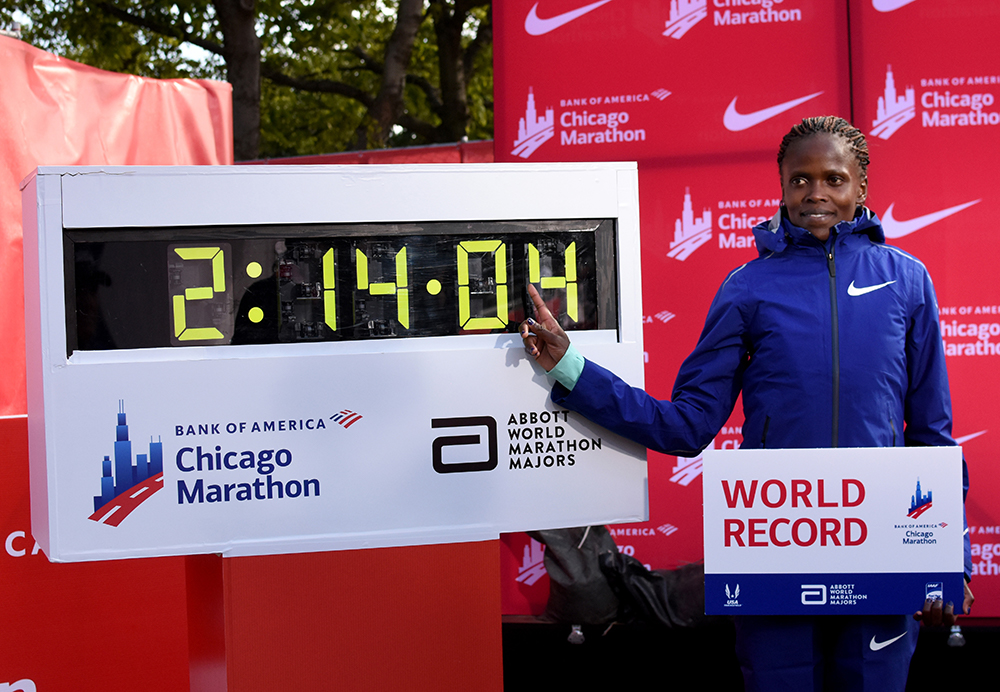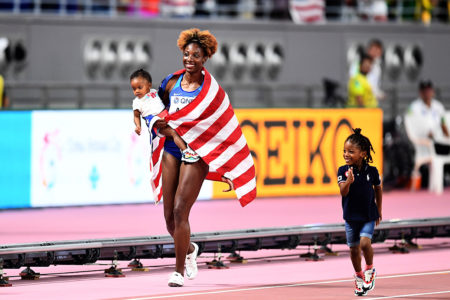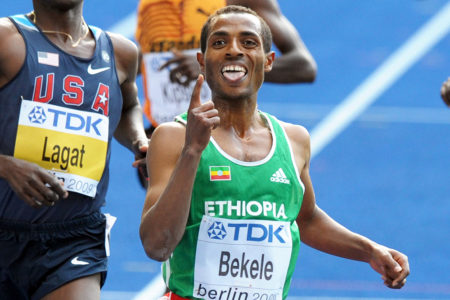
WITH BOTH Eliud Kipchoge and Brigid Kosgei running into the marathon history books on the same weekend wearing Nike Vaporfly shoes—only 2 weeks after Kenenisa Bekele just missed the WR—the question was raised of how much their footwear helped. Nike’s claim for the original Vaporfly 4% was a 4% energy savings, which in theory translates to a 3.4% increase in running speed. If those numbers can be trusted, it means that a world-class marathoner could benefit by 2 minutes or more. Presumably the new Vaporfly Next% has even better numbers. It has been pointed out by Jonathan Gault of LetsRun that the 5 fastest men’s marathons ever have been run since little more than a year ago, and all have been in Vaporflys.
Wrote sport scientist Geoff Burns in an essay carried by the British Journal Of Sports Medicine (BJSM), “The introduction of the Nike Vaporfly in 2017 was the first time in over 40 years that a single factor had been introduced to the sport that seismically shifted performance. The shoe demonstrably improved running speed for a given effort, and like a new species being introduced to an ecosystem without a predator, it quickly saw records being rewritten on the roads from 100M to 5km.”
Now the BJSM is publishing a proposal for the IAAF to regulate road racing shoes. In a nutshell, the authors—doctoral candidate Burns (who works at the Michigan Performance Research Lab) and fellow biomechanist Nicholas Tam—fear that the Nike construction and the rush of other shoe companies to come up with a response could create an “arms race” of shoes that provide more and more aid—at the same time devaluing past and present performances.
The Vaporfly incorporates a variety of cutting-edge technologies, including a carbon fiber plate in the midsole. Says Burns, “You’re extending the effective leg length of the runner with a near-perfect spring, using a combination of ultra-light, highly-resilient foam and a stiff plate.”
The authors maintain that it would be a practical impossibility for the IAAF to regulate the materials inside a midsole, but there is ample precedent to regulate the shoe’s thickness (such as the IAAF already does with high jump and long jump spikes). They propose a 31mm limit, which is what Nike’s early Vaporflys—the prototypes in use at the ’16 Olympics—were measured at. Recent retail models have been measured at 36–37mm. The hoped-for result is that while improvements in engineering may bring more effectiveness to the midsole, a limit on thickness would in effect freeze the arms race at its current state.
But apparently it’s not just a factor on the roads. A number of big recent track performances have come in the spike version of the Vaporfly, which is not yet commercially available but has been supplied to some of Nike’s top athletes. Notably, Sifan Hassan’s 4:12.33 mile World Record and her Doha double of 30:17.62/3:51.95 were helped along by her cutting-edge spikes. (Continued below)
Not A New Question ?
So while the Burns/Tam proposal focuses on road running, Burns confirms that the issue is just as real on the oval. “If the spikes Hassan was wearing added ~1cm under the forefoot of a highly resilient material without adding weight,” he says, “it could be about a 1% improvement in running economy from the longer leg alone, which could be 1.5–2 seconds in a 1500/mile.” He adds that those numbers don’t consider “the benefit of the energy storage and return from the plate and material.”
And even without the spikes being readily available, the basic Vaporfly road shoe is already being used in track 10Ks at the collegiate level. Reportedly most of the 6 BYU runners in the NCAA 10,000 in June wore Vaporflys. Says Burns, “If you’re a Nike-sponsored NCAA school, you could be at a huge advantage.” Will college fans even notice? Of the 20 XC squads that currently occupy the current top 10 spots on the men’s and women’s USTFCCCA poll, 60% are Nike schools. However, expect the 40% of programs that are non-Nike to have something to say.
Hearing voices claiming that the Vaporfly technology is an unfair edge aren’t new. After Laura Muir set a British indoor mile record last winter, complaints reached the IAAF that she was wearing a spike that wasn’t readily available per international rules. The IAAF OKed the spike—but also has a working group studying the issue.






